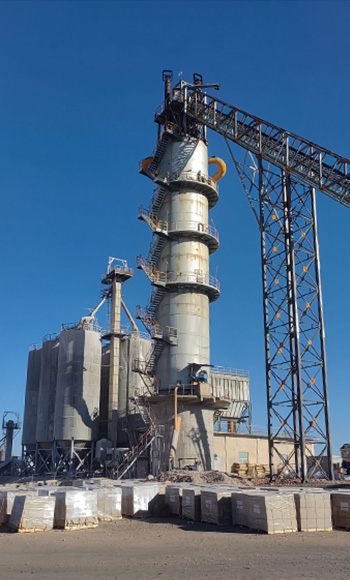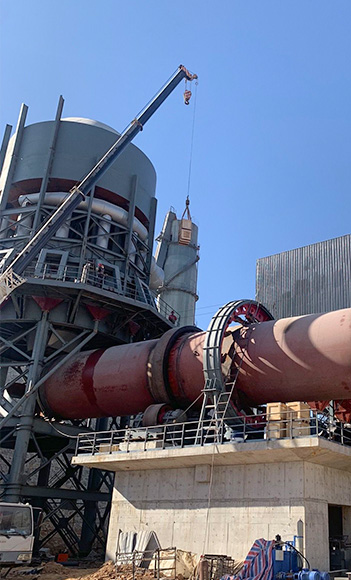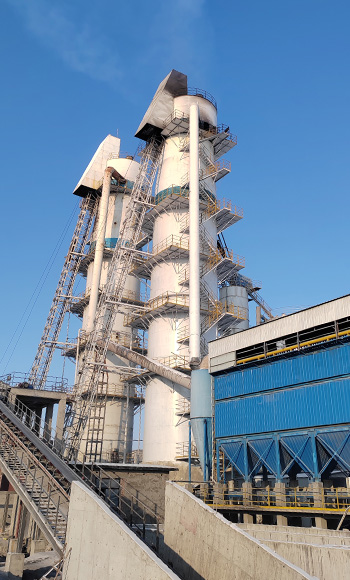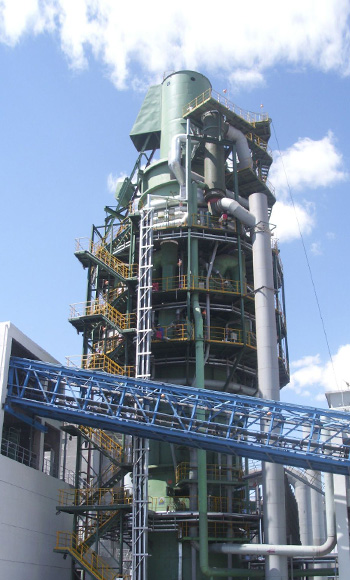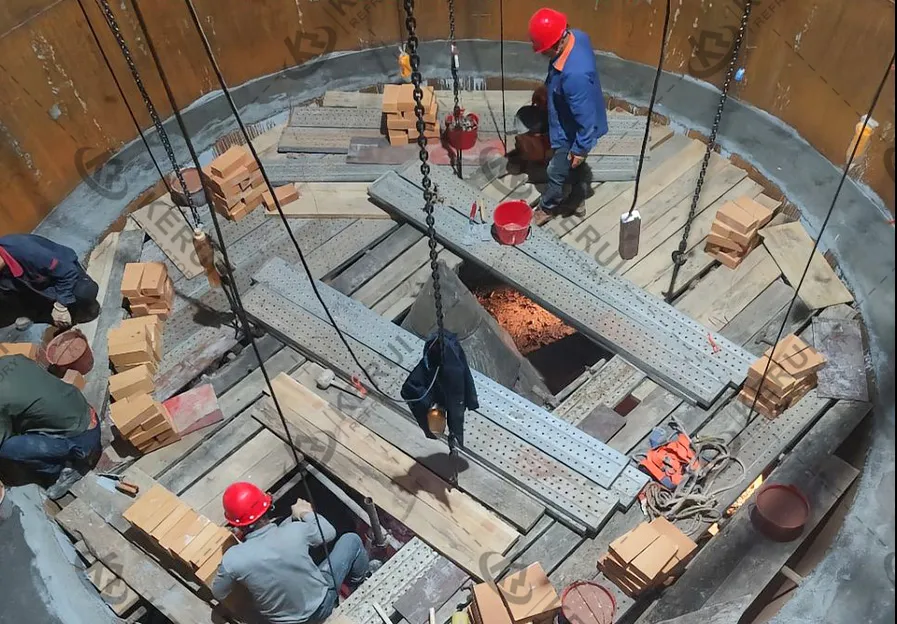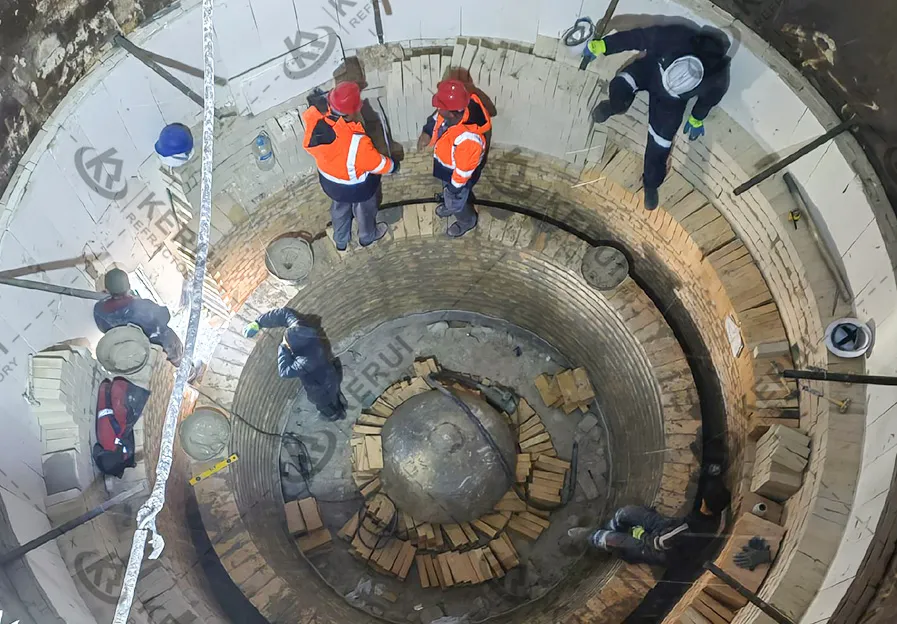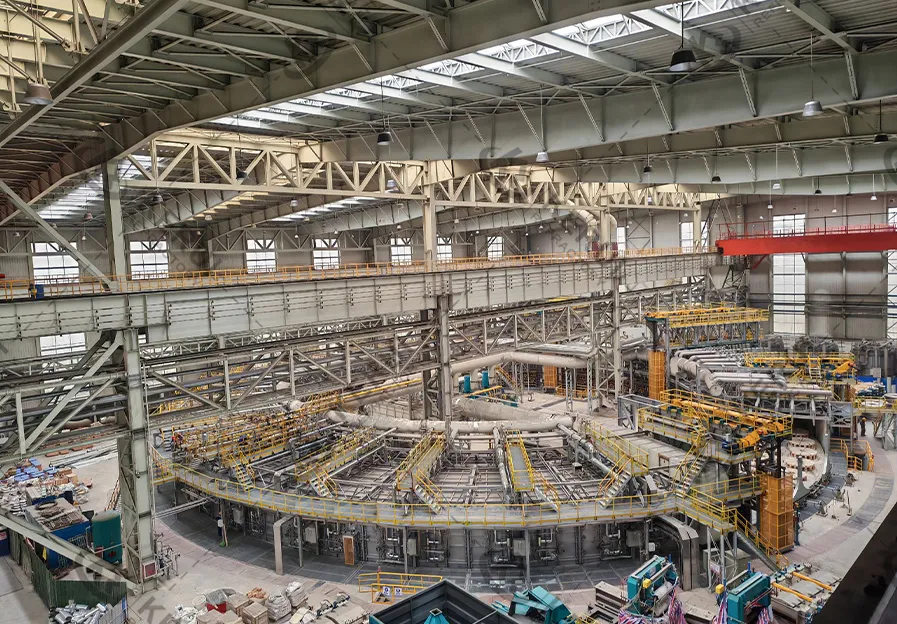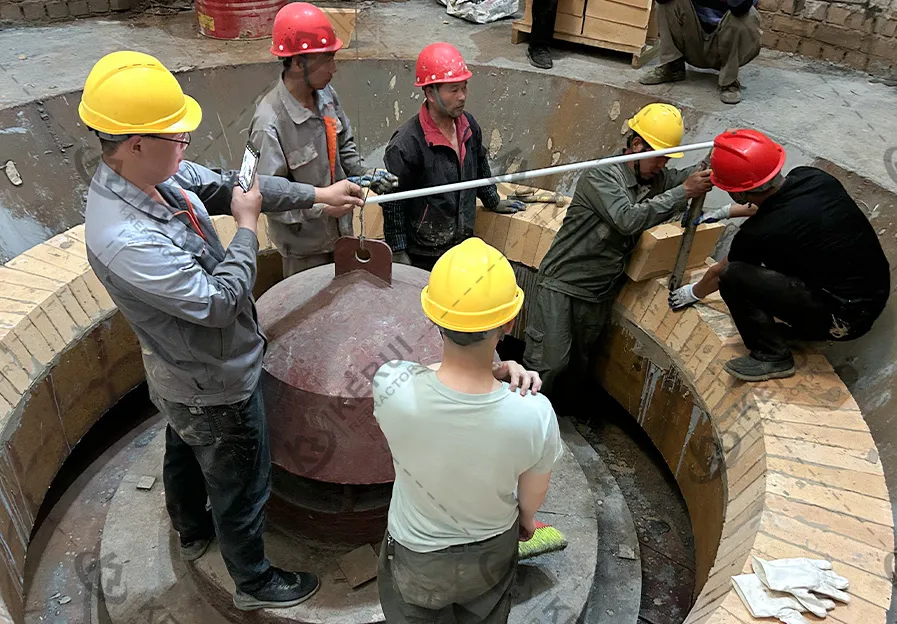Lime Kiln Refractory EPC
With more than 20 years of specialized technical accumulation, Kerui has completed more than 50 lime kiln refractory projects around the world, covering all types of kilns such as shaft kiln, rotary kilns, double-chamber kilns, and sleeve kilns. These projects help customers realize energy saving, emission reduction and efficient production. From thermal simulation engineering to precision construction delivery, Kerui ensures that the kiln operates normally and well. And we have long-term service for strategic cooperation customers, including MAK, Aosen, etc.
Kerui’s EPC Core Services in Lime Kiln Refractory
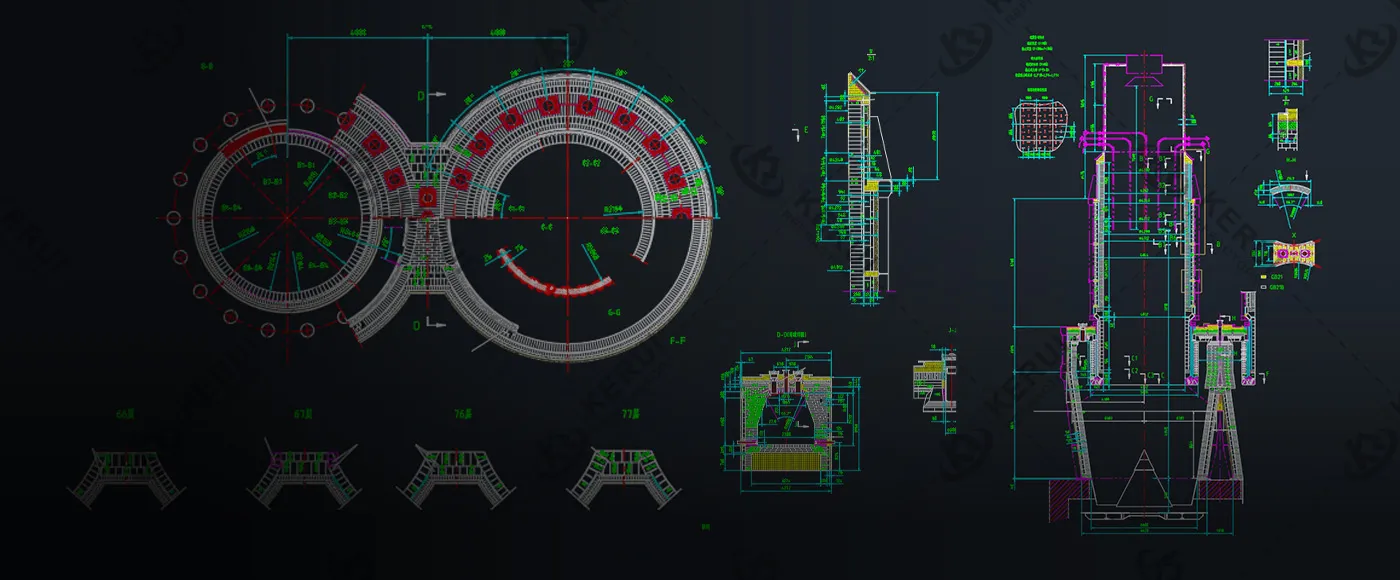
Engineering Services
Detailed Survey and Diagnosis:
Evaluation of existing lime kilns/new kilns, process parameter analysis.
Customized Engineering:
Lime kiln linings structure engineering, refractory material selection and configuration plan (different materials for different regions), thermal simulation calculation.
Drawings and Technical Specifications:
Provide detailed construction drawings and refractory material technical parameter requirements.
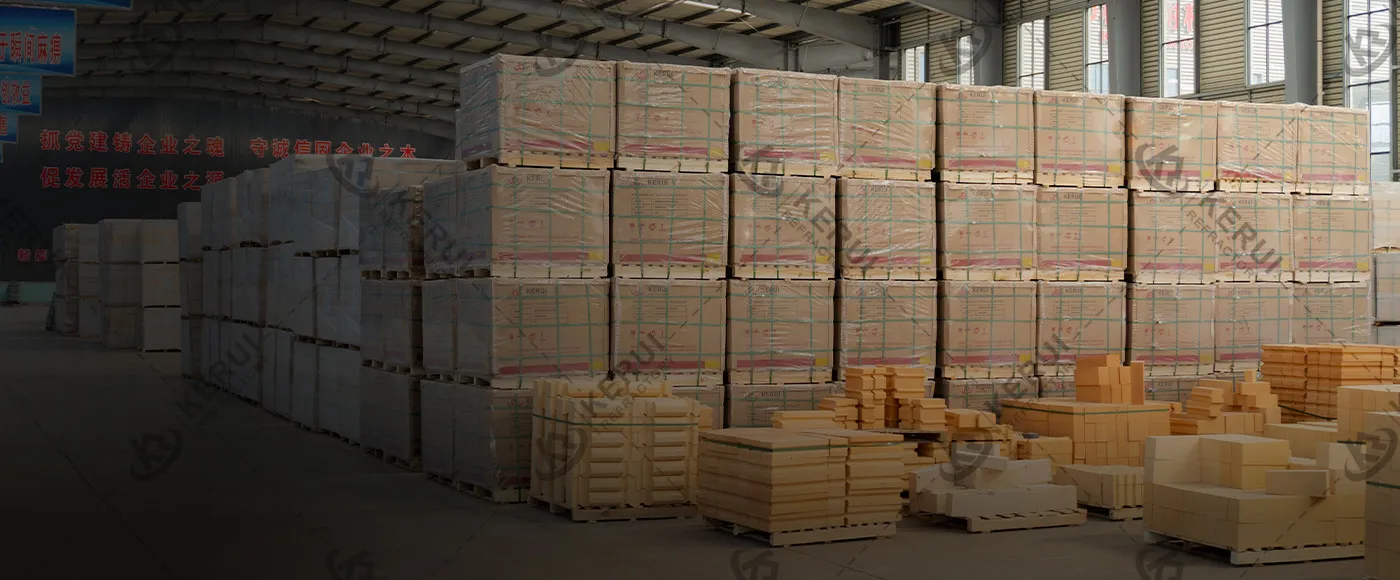
Procurement Services
High-quality Resources:
In addition to our own high-quality refractory products, Kerui has established strategic cooperation with well-known equipment suppliers.
Strict Quality Control:
Incoming material inspection, performance testing (laboratory records can be provided).
Logistics management:
Ensure that refactory materials arrive on time and safely.
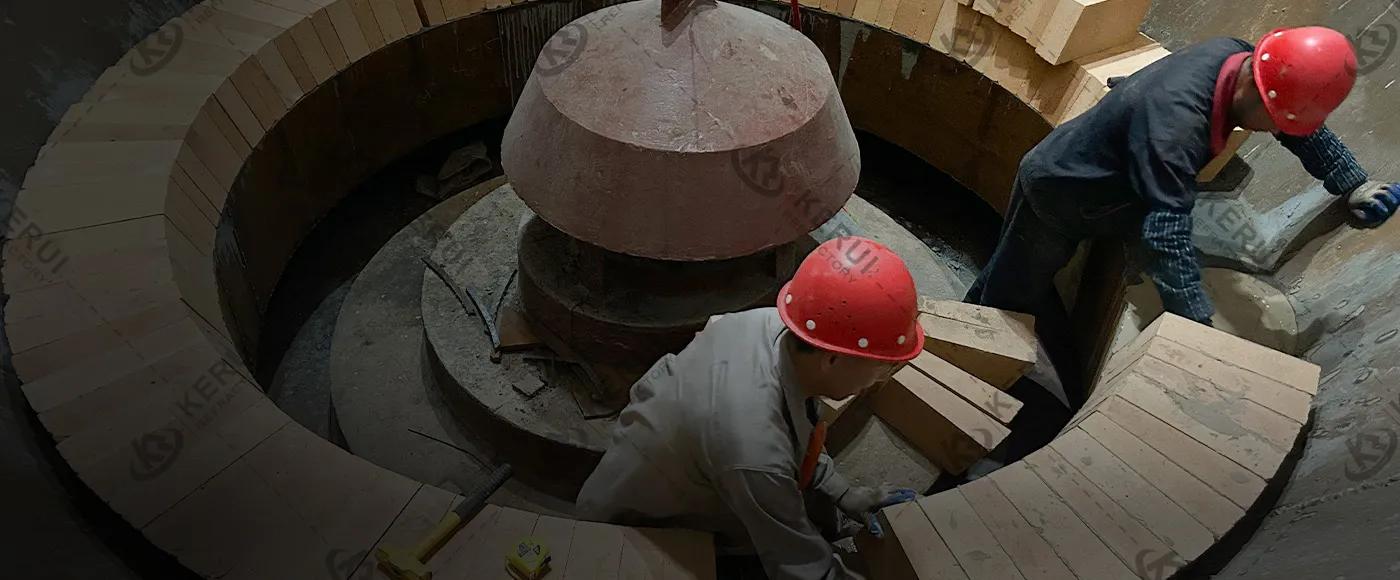
Construction Services
Professional Construction Team Guidance:
Guidance from skilled workers with rich experience in lime kiln masonry.
Standardized Construction Process:
Demonstrate key construction process guidance (such as masonry, anchoring, castable construction, expansion joint treatment).
Quality Management System:
Construction process monitoring, quality inspection and acceptance standards.
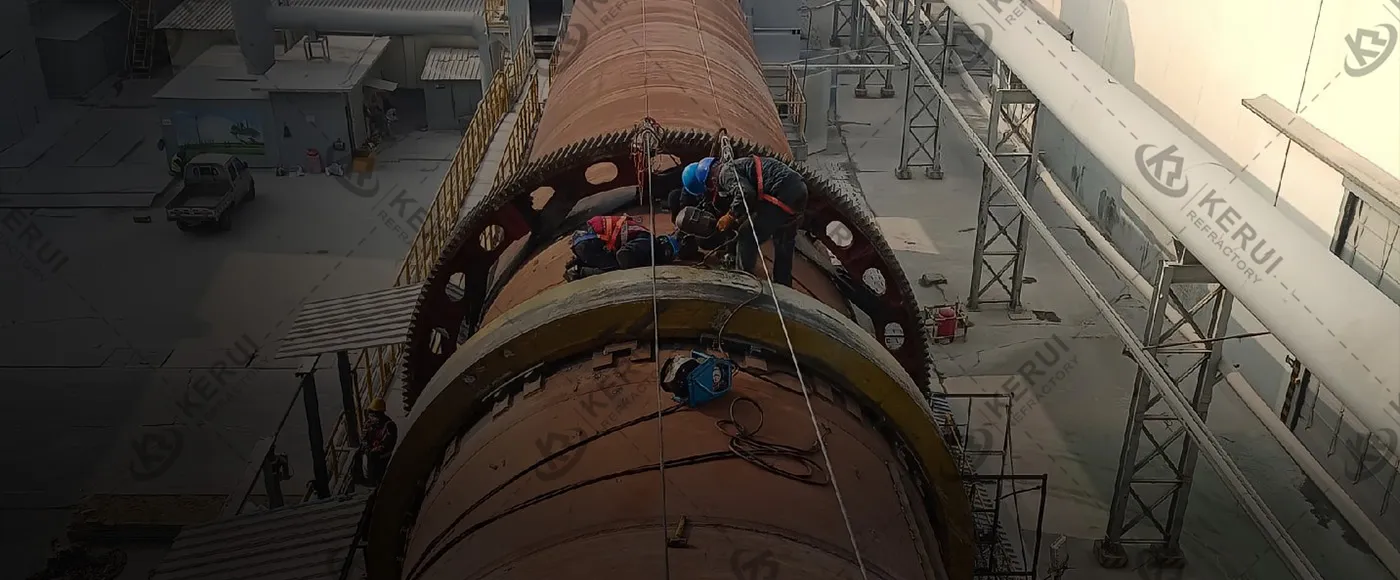
Value-added Services
Operation and Maintenance Consultation:
Best practice recommendations for start-up, shutdown, and thermal cycling procedures.
Refractory Life Assessment and Prediction:
Predictive maintenance planning based on kiln operating history and material behavior.
Local Maintenance and Emergency Repair Services:
24/7 emergency support for unplanned shutdowns or refractory failure.
Lime Kiln Refractory Linings
Lime kiln is used to calcine limestone at high temperature to produce quicklime. As a key thermal equipment for metallurgy, environmental desulfurization, chemical synthesis and cement production, its operating efficiency directly determines the quality of end products and energy consumption costs. EPC service of Kerui Refractory covers all scenarios of kiln types.
Part.1 Shaft Lime Kiln Refractories
Shaft kiln is mainly used to produce ordinary lime. It adopts a vertical cylindrical single-chamber design with a simple structure and low investment.
- Capacity: Small and medium scale (usually ≤300 tons/day);
- Refractory Focus: Withstand vertical mechanical loads and material wear.
| Location | Temp. Range | Characteristics | Suitable Refractories |
| Kiln Throat | 120–300°C | Impact resistance; | Steel fiber-reinforced refractory castable; |
| Preheating Zone | 300–800°C | Thermal shock resistance;
Chemical erosion resistance (CO₂, sulfides); | Fireclay brick;
55% alumina brick;
Lightweight insulating brick; |
| Burning Zone | 1000–1300°C | High-temperature strength;
Alkali erosion resistance;
Abrasion resistance; | Magnesia brick or magnesia chrome brick;
Dolomite brick;
75% alumina brick;
SiC brick;
|
| Burner Perimeter | 1050–1550°C | Flame erosion resistance; | Corundum brick or chrome corundum brick; |
| Kiln Lining Insulation | 200–1000°C | Heat loss reduction;
Shell protection; | Calcium silicate board;
Ceramic fiber blanket;
Lightweight refractory castable;
|
| Cooling Zone | 800–200°C | Thermal shock resistance;
Mechanical wear resistance (lime falling impact); | High-strength alumina brick;
Phosphate-bonded brick;
Abrasion-resistant castable;
|
| Discharge Outlet | 60–150°C | Thermal shock;
Mechanical wear;
Alkali erosion;
Sudden temperature changes.
| Abrasion-resistant castable or SiC brick. |
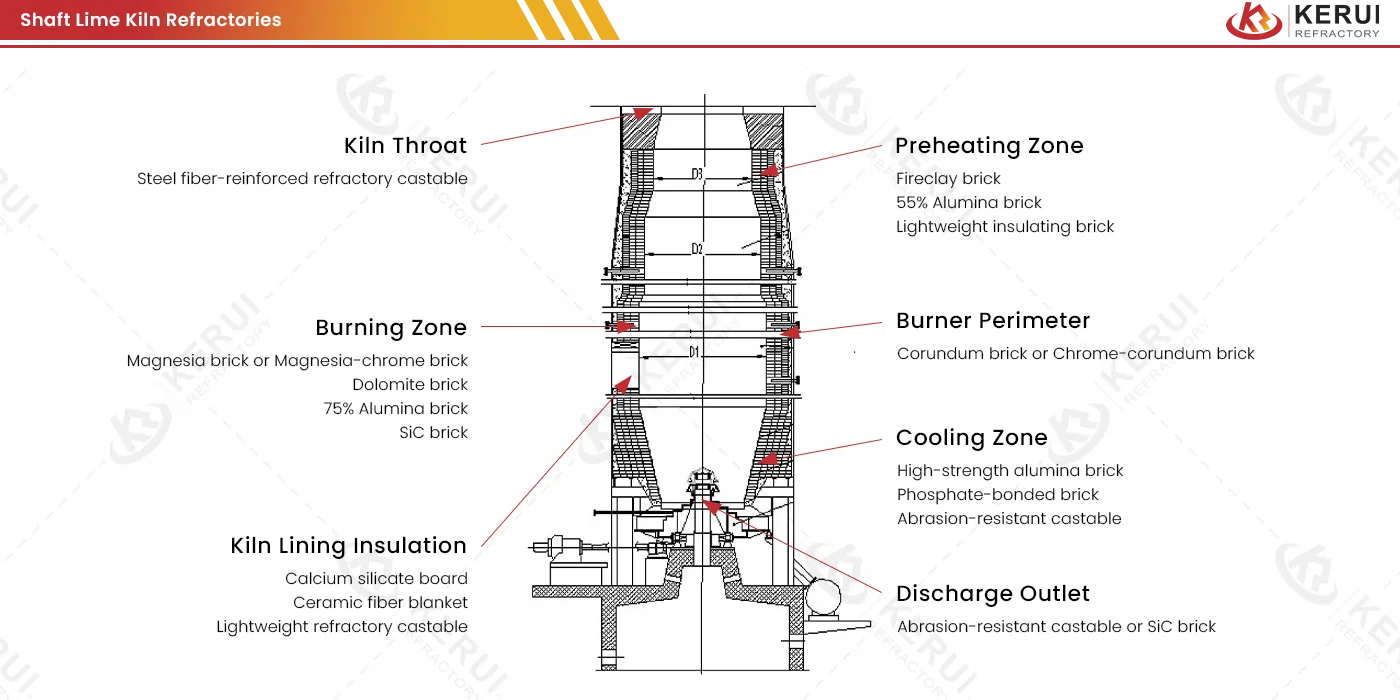
Part.2 Rotary Lime Kiln Refractory
Rotary kiln is widely used in cement, refractory raw materials and metallurgical industries. The core is an inclined steel cylinder, which causes the material to tumble and calcine through slow rotation.
- Capacity: 300-1200 tons/day;
- Refractory Characteristics: It needs to adapt to dynamic thermal stress. And different calcined materials (limestone/dolomite, and others) use differentiated refractory solutions.
| Location | Temp. Range | Characteristics | Suitable Refractories |
| Preheating Zone | 800–1000°C | Moderate temperatures requiring thermal cycling resistance;
Resist CO₂/sulfide gas attack;
Thermal shock stability for frequent kiln starts/stops; | 55-75% high alumina brick;
Fireclay brick; |
| Transition Zone | 1000–1300°C | Steep thermal gradients demanding thermal shock stability;
Chemical transition with partial CaO/sulfide attack; | Phosphate-bonded high alumina brick;
30-50% SiC composite brick; |
| Burning Zone | 1300–1450°C | Sustained ~1400°C exposure;
Alkali resistance against CaO/K₂O/Na₂O;
Thermal shock stability to prevent spalling; | 50-70% MgO magnesia alumina spinel brick;
Dolomite brick (≥90% MgO+CaO); |
| Cooling Zone | <800°C | Mechanical wear from falling lime particles;
Thermal shock from cooling air; | ≥75% alumina abrasion-resistant castable; |
| Kiln Head/Discharge | 1000–1200°C (Head);
200–400°C (Discharge); | Extreme abrasion from lime product & particles;
High-temperature oxidation at kiln head; | ≥85% Al₂O₃ corundum-mullite brick;
≥60% SiC castable. |
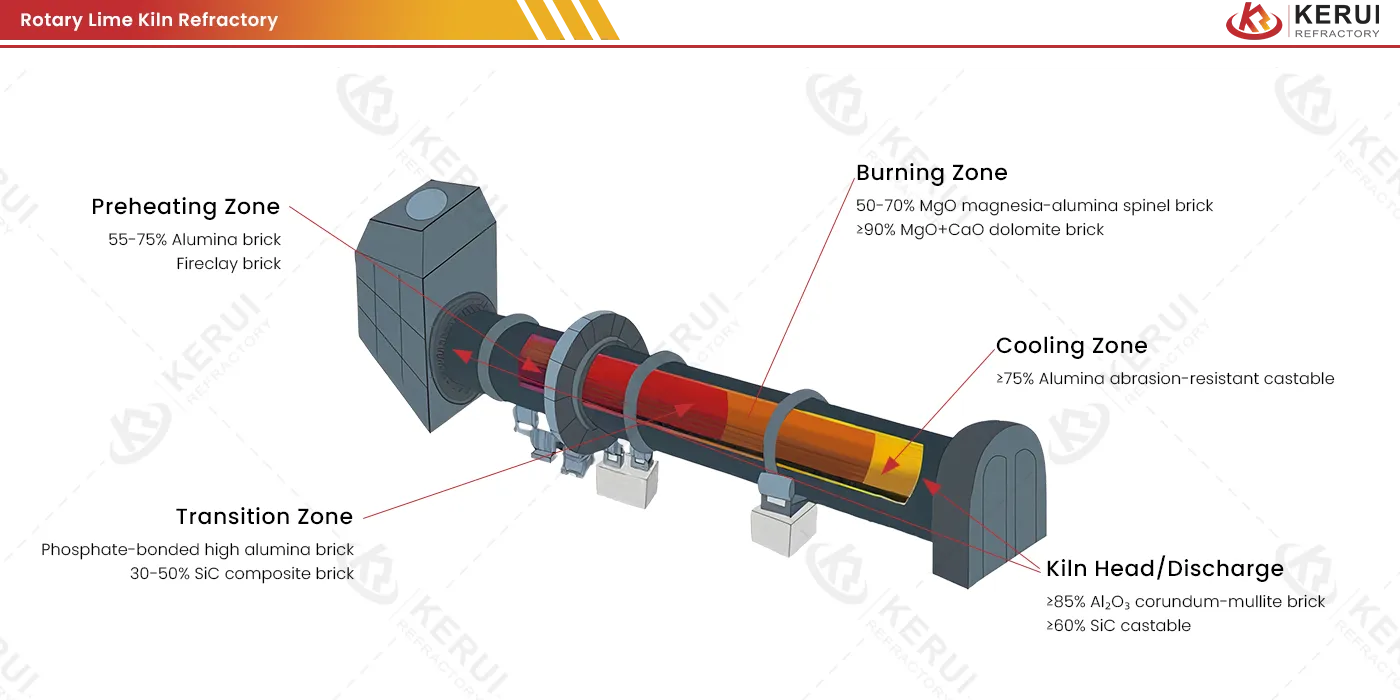
Part.3 Twin Shaft Lime Kiln Refractory
Twin shaft kiln is an energy-efficient dual-shaft structure. The two kiln chambers alternately calcine and preheat to achieve waste heat recovery.
- Capacity: 400-800 tons/day;
- Refractory Core Requirements: Extreme temperature alternation requires materials to have ultra-high thermal shock stability (>30 rapid cooling and heating cycles).
| Location | Temp. Range | Characteristics | Suitable Refractories |
| Preheating Zone | 800–1000°C | Thermal shock resistance (violent temp. swings from reversing cycles);
Resist CO₂/sulfide attack;
Moderate refractoriness & long-term stability; | 55-65% high alumina brick;
Low-cement high alumina castable (irregular areas); |
| Burning Zone | 1200–1400°C | Extreme temperature resistance (≥1400°C);
Alkali resistance (CaO, K₂O, Na₂O);
High thermal shock stability (reversing combustion); | Magnesia alumina spinel brick (MgAl₂O₄, 50-70% MgO);
≥90% MgO+CaO dolomite brick; |
| Cooling Zone | <800°C | Abrasion resistance (lime particle impact);
Thermal shock resistance (cooling air);
High compressive strength (material load); | ≥75% Al₂O₃ abrasion-resistant castable;
Phosphate-bonded high alumina brick; |
| Insulation Layer | 800-1200°C | Low thermal conductivity (energy efficiency);
Lightweight (reduced kiln load); | Nano-microporous insulation boards;
Ceramic fiber modules; |
| Crossover Channel | 1100-1250°C | Exceptional thermal shock resistance (1000°C - 1400°C swings);
Gas erosion resistance (high-velocity dust-laden flow);
Chemical corrosion resistance (S, CO gases); | ≥70% SiC silicon carbide brick;
≥85% Al₂O₃ corundum-mullite brick. |
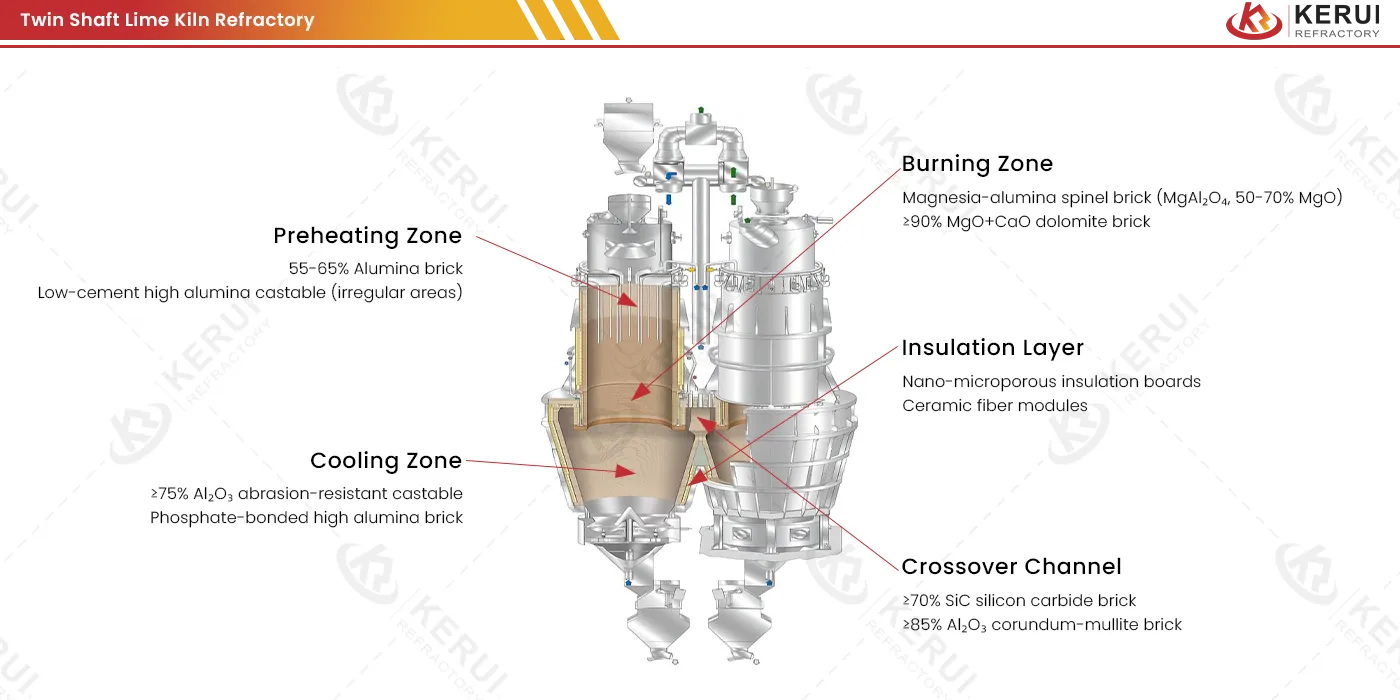
Part.4 Annular Shaft Kiln Refractories
Sleeve kiln adopts a unique double-tube design (inner tube + outer tube), which allows hot gas and limestone to flow in the same direction through the principle of parallel calcination, with uniform heat distribution and high activity.
- Capacity: 500-1000 tons/day;
- Refractory Challenges: The inner tube is subjected to high temperature corrosion + mechanical stress, and the magnesia alumina spinel bricks need to be resistant to CO erosion.
| Location | Temp. Range | Characteristics | Suitable Refractories |
Preheating Zone
(Outer Shell) | 800–1000°C | Moderate thermal stress;
Material abrasion at high-flow areas;
Cyclic temperature variations; | 55-65% high alumina brick;
≥70% SiC brick (material impact areas);
|
Burning Zone
(Inner Cylinder) | 1200–1400°C | Peak temperature exposure;
Severe CaO alkali attack;
Thermal cycling from kiln operations;
Steep radial thermal gradients; | Magnesia alumina spinel brick
(MgAl₂O₄, 50-70% MgO); |
| Burner Perimeter | 1200-1600°C | Direct flame impingement;
High-velocity particle erosion;
Sulfur attack (petroleum coke fuels);
Thermal spalling risk; | 99% Al₂O₃ corundum brick;
Chrome-corundum brick (Cr₂O₃ 5-15%); |
Cooling Zone
(Bottom Section) | ≤800°C | Mechanical wear from falling lime;
Thermal shock during quenching;
Structural loading;
Joint integrity challenges; | ≥75% Al₂O₃ castable (seam-free construction);
Phosphate-bonded high alumina brick. |
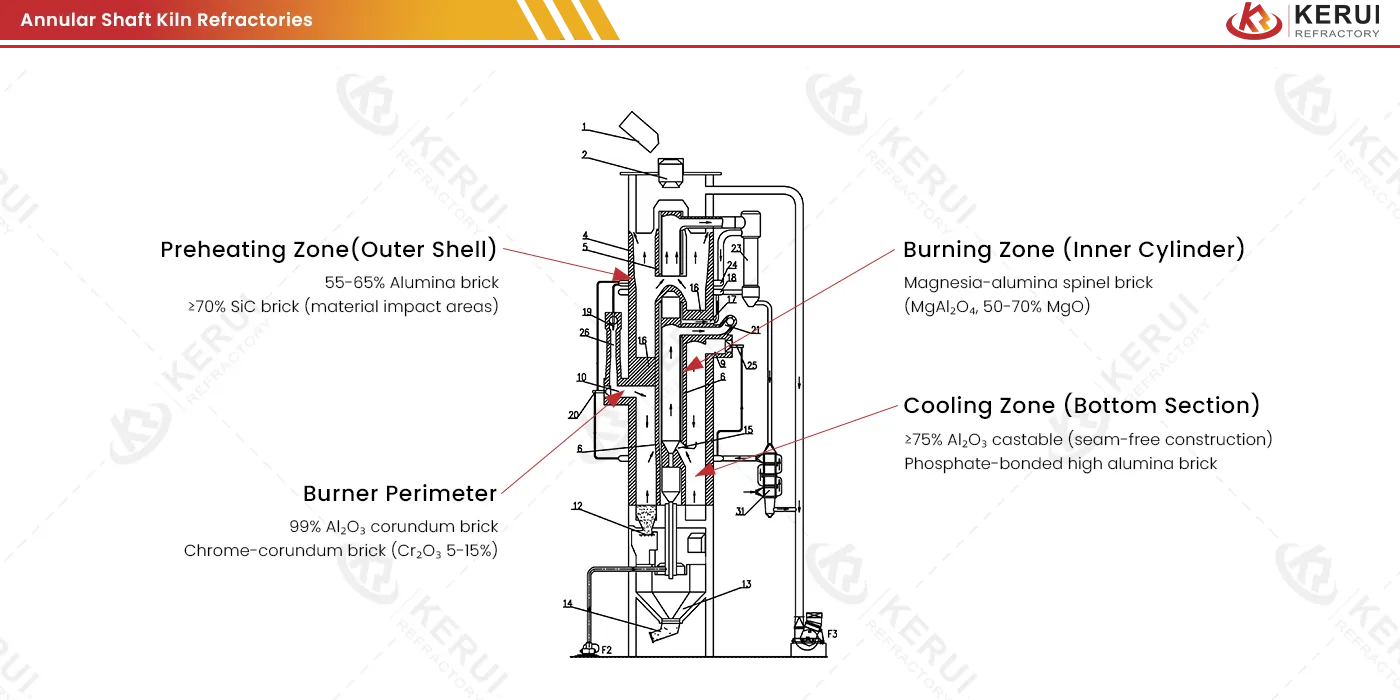
Cases Site of Kerui Lime Furnace Refractories
Cement Lime Plant Modernization
Country: Turkey;
Project: Revamp of 800 tpd annular shaft kiln.
-
Kerui Solution:
Burner Zone: Cr₂O₃-enhanced corundum bricks.
-
Customer Feedback:
“After 24 months operation, bricks show only 15mm wear depth versus 35mm with previous supplier. Fuel efficiency improved 8%.”
Quicklime Plant for Steel Mill
Country: Vietnam;
Project: New twin-shaft kiln (1,200 tpd capacity).
-
Kerui Solution:
Crossover Channel: 80% SiC bricks;
Cooling Zone: Phosphate-bonded alumina brick.
-
Customer Feedback:
“Zero spalling observed during 18 thermal cycles in first year. Maintenance downtime reduced from 12 days/year to 3 days.”
Petrochemical Lime Facility
Country: Saudi Arabia;
Project: Petroleum coke-fired annular kiln.
-
Kerui Solution:
Burner Perimeter: Chrome-corundum bricks (12% Cr₂O₃);
Insulation: Nano-microporous boards (λ=0.08 W/m·K).
-
Customer Feedback:
“Bricks resist 1.8% sulfur fuel; Shell temperature dropped 75°C, reducing heat loss by 22%.”
Mining Group Lime Production
Country: Chile;
Project: High-abrasion lime kiln for copper smelting.
-
Kerui Solution:
Preheating Zone: 70% SiC bricks in flow channels;
Discharge: SiC-reinforced castable.
-
Customer Feedback:
“Outlet refractory life extended from 8 to 14 months despite 40% higher throughput. Wear resistance also exceeded expectations.”
Choose Professionalism, Choose Reliability, Choose Kerui

Focused Areas
20 years of experience in the EPC lime kiln refractory field.

Strong Technical Team
Technical staff can assist in material selection, drawing,and other comprehensive services.

Rich Experience
50 lime kiln refractory EPC projects have been completed.

Full Process Control Capabilities
Kerui Refractory possesses seamless connection of engineering, manufacturing, delivery, and construction and quality assurance system (ISO certification, etc.).

Environmental Compliance
Kerui lime kiln refractories meet stringent global environmental standards through, including material safety, production eco-control, energy efficiency contribution.

Continuous Innovation
Kerui enhances lime kiln EPC projects through continuous R&D, scientific collaboration, and advanced technologies for efficiency and sustainability.
FAQs of Lime Furnace Linings:
-
What is the difference between the lime kiln refractory EPC project and the single refractory supply service?
A: -In the EPC project, the contractor undertakes the entire process from engineering, process optimization, equipment procurement, refractory manufacturing, on-site construction to commissioning, provides overall solutions and project management support, and has a fixed price, fixed construction period, and fixed results; The EPC contractor is responsible for overall quality, progress, and overall performance assurance.
-The single supply service is only responsible for the production and delivery of refractory products, and the subsequent installation, quality control, commissioning and overall process management are handled by the customer. In the single supply method, the subsequent risks are mainly borne by the customer himself.
-
What is the usual delivery cycle of the lime kiln refractory EPC project?
A: The usual delivery cycle is generally 18–36 months. Contact us for the detailed lists and period.
-
Are you facing short kiln lining life and frequent kiln shutdowns for maintenance?
A: To minimize thermal stress and extend kiln lining life, prioritize thermal shock-resistant refractories, ensure proper installation—especially at joints—optimize firing cycles, and proactively inspect and replace worn sections.
-
Are you struggling with excessive energy consumption and finding it difficult to control production costs?
A: Upgrade to high-insulation refractories, ensure tight lining seals to prevent hot gas leaks, and optimize combustion/airflow for efficient heat transfer within the kiln.
-
Is unstable kiln operation impacting your product quality and production output?
A: Achieve a stable, uniform lining profile to ensure consistent heat distribution and material flow; Promptly repair damaged sections causing hotspots or flow disruptions.
-
Is improper refractory selection leading to severe localized erosion in your kiln?
A: Select abrasion/chemical-resistant refractories specific to high-wear zones (e.g., burning zone, transition areas); Consider zoning the lining with different materials.
-
Is poor construction quality compromising the performance of your refractories?
A: Mandate strict quality control during installation (mix ratios, curing, drying, joint integrity) using experienced contractors; Proper drying/sintering is critical.
-
Is a lack of overall system optimization causing mismatched lifespans among different kiln components?
A: Implement a zoned lining design using optimized materials for each section’s thermal, chemical, and mechanical demands to synchronize replacement schedules.
-
How do kiln shutdown/cooling procedures impact lining life?
A: Rapid cooling causes severe thermal stress and cracking. Enforce strict, controlled cooling protocols during shutdowns to maximize refractory integrity.
-
Why does material impact during charging damage the lining?
A: Direct impact from limestone feed causes spalling and abrasion. Optimize chute design, particle size, and drop height to minimize direct lining impact.
-
How does thermal cycling fatigue affect the lining?
A: Repeated heating/cooling cycles cause expansion/contraction stress, leading to microcracking and eventual spalling. Use materials with high cyclic spalling resistance and stabilize kiln temperature operation.
-
Can improper flame pattern/combustion damage the lining?
A: Yes. Overly aggressive or misdirected flames cause localized overheating and accelerated chemical attack. Optimize burner settings and positioning for even heat distribution.
-
How critical is alkali/slag attack, and how to mitigate it?
A: Very critical. Alkali vapors infiltrate and degrade refractories. Use dense, low-porosity materials with high alkali resistance in the upper transition/preheating zones and manage fuel/raw material chemistry.
